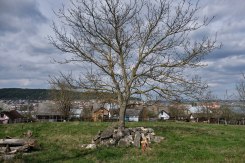Today was the first day of a new trip through Galicia with my friends Marla, Jay, Alex and Vasyl. On our way to Ternopil we stopped in the towns of Bibrka, Rohatyn, Berezhany and Kosova to visit its Jewish heritage sites. As different as those towns are, as different is what is preserved there.
The weather was much better than predicted by the forecast. It was warmer than I expected, we had sunshine in between, the trees show fresh green and the storks were busy with nest building. Spring came to Galicia.
Bibrka was originally not on our list of places to go. But as Vasyl choosed the route via Bibrka we had a stop at the synogogue which is in poor condition. It would not be the last building we saw today with low expectations to survive.
Rohatyn is a familiar place to all of our small group – in particular for Marla who has family roots there. She and Jay have set up an organisation for the preservation of the local Jewish heritage. I have not been to the mass grave sites where Rohatyn’s Jews were murdered during the German occupation, and I asked my friends to show me the places. Marla and Jay have already an agreement with the municipality for an survey of this sites during the upcoming summer. They are hoping to find the exact location and size of the mass graves. So far, knowledge about both sites is vague. One site has been built over by greenhouses, the other one is outside of town. A calm place, where a farmer was plowing his field while we looked into the wide open space of the Galician landscape.
Berezhany bewitched us with the beauty of its Austro-Hungarian old town. The town reflects Galicia’s multi-ethnic past. Poles, Ukrainians, Armenians and Jews used to live here. The territory of the Jewish cemetery offers an amazing view over the surrounding neighborhoods, forests, hills and valleys. Many tombstones have been destroyed or are toppled, but somebody obviously takes care of the cemetery and keeps grass, wines and bushes short.
While there is hope for Berezhany’s old Armenian church were restoration works make progress, the future of the former Great Synagogue looks bleak. Since my visit in 2013 the situation worsened. Walls are in danger to collapse and rampant vegetation takes the place over.
There is more hope for the small synagogue in neighboring Kosova. The build is under restoration and will hopefully be a home for a museum. It took us some time to find the remains of the Jewish cemetery. Thanks to Jay’s old maps we finally manage to do so. We found mainly empty space and only fragments of tombstones. While looking around a man with a dog joined us. He introduced himself as Ihor. He owns a house directly next to the cemetery. “My grandmother remembered the Jews of Kosova”, he told us, “and she also witnessed how they were shot by the Germans not far from here”.
We asked him about the cemetery and why nearly nothing is preserved. “The Soviets wanted to build a factory on the territory of the cemetery and destroyed everything”, he explained. “They wanted us to forget who we are and how we lived”, Ihor said. But Ihor remembers.

This work is licensed under a Creative Commons Attribution-NonCommercial-NoDerivatives 4.0 International License.



















Int Paternal grandparents came from Zuravno, Galicia ( Austria /Poland)
I am wondering if you also explored that area?
The region yes, the town itself not…
Any hints what to visit there?
Dear Herman, again my congratulations to your job.
Daniel, Brazil
Christian
If this place was considered the Jewish nirvana The rest is left tu you !
Hardy
I wonder what’s left of my grandmother’s birthplace, Kozliv (formerly Kozlow) near Ternopil.
Brilliant presentation Christian — thank you!
jerome
I am just now in Berezhany and I want to go to to the cemeteries of Kozova and this town. But you gave not hint, where to find them! Please help until tomorrow!
Dear Martin,
the Jewish cemetery of Berezhany is here: https://www.google.de/maps/place/49%C2%B026'33.9%22N+24%C2%B055'47.1%22E/@49.4427608,24.9286089,369m/data=!3m2!1e3!4b1!4m6!3m5!1s0x0:0x0!7e2!8m2!3d49.4427595!4d24.929738
For Kozova you have to ask on the ground; I don’t remember the location.
Good luck!
Thank You so much! I asked a lot of people and I found the location: 49.426337, 25.143007 (Google Maps). The fence is destroyed, chickens enter, everything is overgrown with grass.